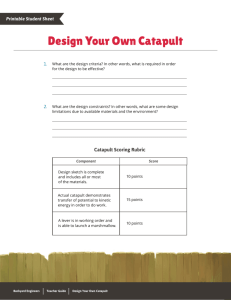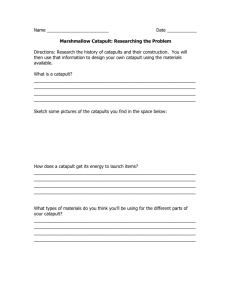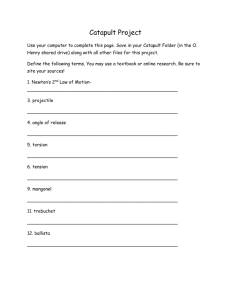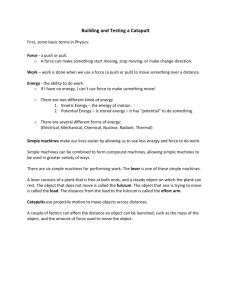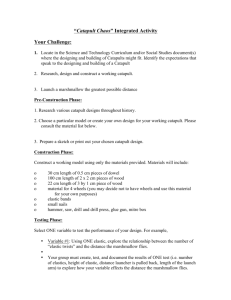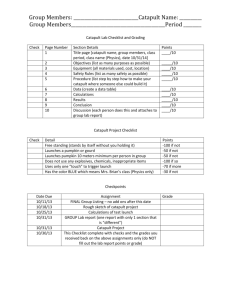Projectile Motion Gillis CATAPULT PROJECT
advertisement
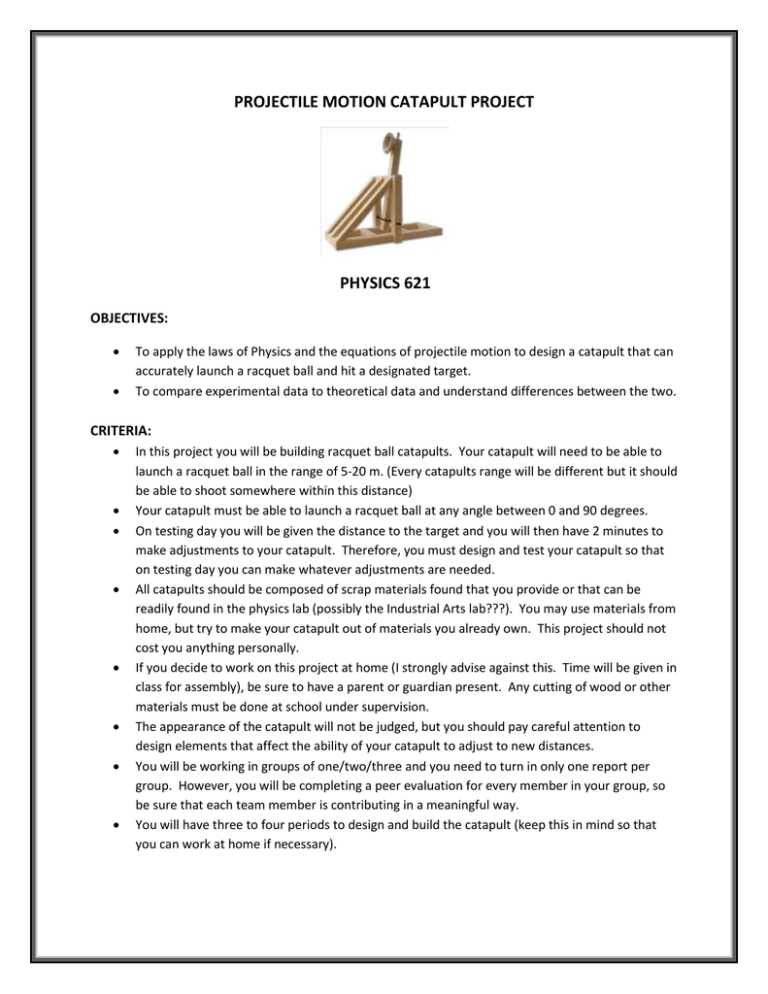
PROJECTILE MOTION CATAPULT PROJECT PHYSICS 621 OBJECTIVES: To apply the laws of Physics and the equations of projectile motion to design a catapult that can accurately launch a racquet ball and hit a designated target. To compare experimental data to theoretical data and understand differences between the two. CRITERIA: In this project you will be building racquet ball catapults. Your catapult will need to be able to launch a racquet ball in the range of 5-20 m. (Every catapults range will be different but it should be able to shoot somewhere within this distance) Your catapult must be able to launch a racquet ball at any angle between 0 and 90 degrees. On testing day you will be given the distance to the target and you will then have 2 minutes to make adjustments to your catapult. Therefore, you must design and test your catapult so that on testing day you can make whatever adjustments are needed. All catapults should be composed of scrap materials found that you provide or that can be readily found in the physics lab (possibly the Industrial Arts lab???). You may use materials from home, but try to make your catapult out of materials you already own. This project should not cost you anything personally. If you decide to work on this project at home (I strongly advise against this. Time will be given in class for assembly), be sure to have a parent or guardian present. Any cutting of wood or other materials must be done at school under supervision. The appearance of the catapult will not be judged, but you should pay careful attention to design elements that affect the ability of your catapult to adjust to new distances. You will be working in groups of one/two/three and you need to turn in only one report per group. However, you will be completing a peer evaluation for every member in your group, so be sure that each team member is contributing in a meaningful way. You will have three to four periods to design and build the catapult (keep this in mind so that you can work at home if necessary). FORMAL REPORT: You will be graded on the following items: 1.) Design Plan 2.) Data Analysis 3.) Organization and Presentation of Report 4.) Conclusion *** PLEASE SEE THE RUBRIC FOR ADDITIONAL DETAILS *** 1.) YOUR DESIGN PLAN MUST INCLUDE: a.) A list of materials used (should be bulleted) b.) A diagram of your catapult (preferably done on a computer drawing program). The diagram should have all dimensions labeled (including units) and should be neatly presented. Your diagram should be drawn or printed on plain white paper and should fill most of a single page. 2.) YOUR DATA ANAYLSIS MUST INCLUDE: a.) Data table that includes time of flight (s), distance flown in horizontal direction, and the angle of launch. Complete calculations for one sample trial should be included in this section. (Please type) b.) A value for the average initial velocity of the marshmallow and an explanation of how initial velocity of the marshmallow was determined. c.) How did changing the angle affect the characteristics of you trajectory? The initial velocity? (Can be answered in the “Conclusion” section of your report) 3.) ORGANIZATION AND PRESENTATION: a.) The report should be neatly typed and sections should be well marked with titles. b.) The report should be proofread for any spelling mistakes. c.) All calculation shown in the report should be done using the problem solving strategy explained in class. d.) All answers are presented in complete sentences excluding the list of materials which should be bulleted. 4.) CONCLUSION: Your conclusion should include an overview of your findings and describe any sources of error that might be present. Possible design alterations for future versions could be included here as well. The answers to any questions asked during the project should be answered in this section. Physics 621 Catapult Project Peer Evaluation Rubric / 24 4 Group member participated fully and was always on task in class. 3 Group member participated most of the time and was on task most of the time. 2 Group member participated but wasted time regularly or was rarely on task. 1 Group member did not participate, wasted time, or worked on unrelated material. Group member assumed leadership in an appropriate way when necessary by helping the group stay on track, encouraging group participation, posing solutions to problems, and having a positive attitude. Group member listened carefully to others’ ideas. Group member sometimes assumed leadership in an appropriate way. Group member usually allowed others to assume leadership or often dominated the group. Group member did not assume leadership or assumed it in a nonproductive manner. Group member usually listened to others’ ideas. Feedback Group member offered detailed, constructive feedback when appropriate. Group member offered constructive feedback when appropriate. Group member did not listen to others and often interrupted them. Group member did not offer constructive or useful feedback. Cooperation Group member treated others respectfully and shared the workload fairly. Group member usually treated others respectfully and shared the workload fairly. Time Management Group member completed assigned tasks on time. Group member usually completed assigned tasks on time and did not hold up progress on the projects because of incomplete work. Group member sometimes did not listen to others’ ideas. Group member occasionally offered constructive feedback, but sometimes the comments were inappropriate or not useful. Group member sometimes treated others disrespectfully or did not share the workload fairly. Group member often did not complete assigned tasks on time, and held up completion of project work. Participation Leadership Listening Group member often treated others disrespectfully or did not share the workload fairly. Group member did not complete most of the assigned tasks on time and often forced the group to make lastminute adjustments and changes to accommodate missing work. PHYSICS 621 Catapult Project Rubric & Grading Sheet Deductions Score Catapult (30 points) Ready to go on time (4) Sized appropriate (2) Quality of Construction (10) Trigger (5) Originality (9) ______ ______ ______ ______ ______ Design Log Book (15 points) Detailed progress of project (7) Sketches of catapult (3) Rough calculations (5) ______ ______ ______ Design Report (39 Points) Team names (.5) Neatness (1) Materials List (1) Visual Plans (8) Design Procedure (8) Data Analysis (12) Conclusion (8.5) ______ ______ ______ ______ ______ ______ ______ Launch Capabilities (8 Points) Fired safely (1) Range 2 m (7) ______ ______ Accuracy (8 Points) Hit target “on the fly” within 2 tries (8) ______ Total Score / 100
